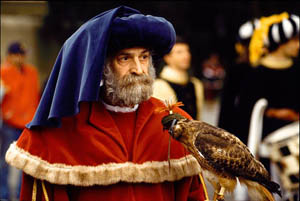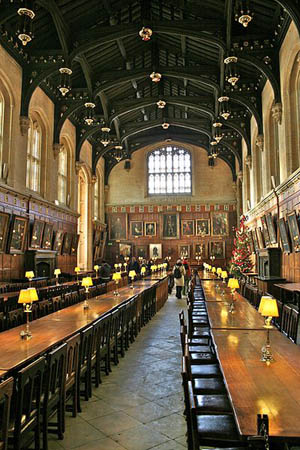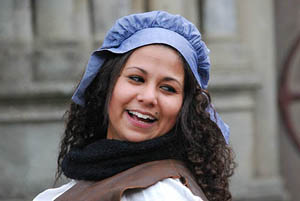Life In A Medieval CastleOfficers & Servants in a Medieval Castle |
|
|
|||||||||||||||||||
Officers & Servants in a Medieval Castle
From the household of the king to the humblest peasant dwelling, more or less distant relatives and varying numbers of servants and dependants would cohabit with the master of the house and his immediate family. The structure of the medieval household was largely dissolved by the advent of privacy in the modern period. As a result of the military nature of the medieval noble household, its composition was predominately male. Towards the end of the medieval period the ratio levelled out somewhat, but at an earlier date the feminine element of the household consisted only of the lady and her daughters, their attendants, and perhaps a few domestics to perform particular tasks such as washing. Many of the male servants were purely military personnel; there would be a gatekeeper, as well as various numbers of knights and esquires to garrison the castle as a military unit. Yet many of these would also serve other functions, and there would be servants entirely devoted to domestic tasks. At the lower level, these were simply local men recruited from the localities. The higher level positions – in particular those attending on the lord – were often filled by men of rank: sons of the lord's relatives, or his retainers. The presence of servants of noble birth imposed a social hierarchy on the household that went parallel to the hierarchy dictated by function. This second hierarchy had at its top the steward (alternatively seneschal or major-domo), who had the overriding responsibility for the domestic affairs of the household. Taking care of the personal well-being of the lord and his family were the Chamberlain, who was responsible for the chamber or private living-quarters, and the Master of the Wardrobe, who had the main responsibility for clothing and other domestic items. Of roughly equal authority as the steward was the marshal. This officer had the militarily vital responsibility for the stables and horses of the household (the "marshalsea"), and was also in charge of discipline. The marshal, and other higher-ranking servants, would have assistants helping them perform their tasks. These – called valet de chambres, grooms or pages, ranking from top to bottom in that order – were most often young boys, although in the larger royal courts the valet de chambres included both young noble courtiers, and often artists, musicians and other specialists who might be of international repute. Assigning these the office of valet was a way of regularising their position within the household. Administration & Household
|
|
||||||||||||||||||
|
|
|||||||||||||||||||
|
In addition to these offices there was a need for servants to take care of the hunting animals. The master huntsman, or the veneur, held a central position in greater noble households. Likewise, the master falconer was a high-ranking officer, often of noble birth himself. One of the most important functions of the medieval household was the procuration, storage and preparation of food. This consisted both in feeding the occupants of the residence on a daily basis, and in preparing larger feasts for guests, to maintain the status of the lord. The kitchen was divided into a pantry (for bread, cheese and napery) and a buttery (for wine, ale and beer). These offices were headed by a pantler and a butler respectively. Depending on the size and wealth of the household, these offices would then be subdivided further. The following is a list of some of the offices one could expect to find in a large medieval aristocratic or royal household:
There would also be staff taking care of the Scullery (&scullion), Chandlery (where candles were made), Ewery, Laundry and Napery. The chapel was a part of every large household. Household chapels would be staffed by varying numbers of clerics. Chaplains, confessors and almoners could serve in administrative capacities as well as the religious ones. Clerics were chancellors in large households. The original chancellors were the Cancellarii of Roman courts of justice, ushers who sat at the cancelli or lattice work screens of a basilica or law court, which separated the judge and counsel from the audience. In medieval households they might be responsible for record keeping, accounting and finances. The households of medieval kings were in many ways simply aristocratic households on a larger scale. In some ways though, they were different. One major difference was the way in which royal household officials were largely responsible for the governance of the realm, as well as the administration of the household. The 11th century Capetian kings of France, for instance, "ruled through royal officers who were in many respects indistinguishable from their household officers." These officers – primarily the seneschal, constable, butler, chamberlain and chancellor – would naturally gain extensive powers, and could exploit this power for social advancement. One example of this is the Carolingians of France, who rose from the position of royal stewards – the Mayors of the Palace – to become kings in their own right. It was the father of Charlemagne, Pepin the Short, who gained control of government from the enfeebled Merovingian king Childeric III. Another example is the royal House of Stuart in Scotland, whose family name bore witness to their background of service. Eventually the central positions of the royal household became little else than honorary titles bestowed upon the greatest families, and not necessarily even dependent on attendance at court. By the thirteenth century, the offices of constable, butler, steward and chamberlain had become the hereditary right of certain high noble families. The royal household differed from most noble households in the size of their military element. If a king was able to muster a substantial force of household knights, this would reduce his dependence on the military service of his subjects. This was the case with Richard II of England, whose one-sided dependence on his household knights – mostly recruited from the county of Cheshire – made him unpopular with his nobility and contributed to his downfall. The medieval aristocratic household was not fixed to one location, but could be more or less permanently on the move. Greater nobles would have estates scattered over large geographical areas, and to maintain proper control of all their possessions it was important to physically inspect the localities on a regular basis. As the master of the horses, travel was the responsibility of the marshal. Everything in the noble household was designed for travel, so that the lord could enjoy the same luxury wherever he went. Even baths and window glass were moved around. Particularly for kings, itineration was a vital part of governance, and in many cases kings would rely on the hospitality of their subjects for maintenance while on the road. This could be a costly affair for the localities visited; there was not only the large royal household to cater for, but also the entire royal administration. It was only towards the end of the medieval period, when means of communication improved, that households, both noble and royal, became more permanently attached to one residence. Aristocratic society centred on the castle originated, as much of medieval culture in general, in Carolingian France, and from there spread over most of Western Europe. In other parts of Europe, the situation was different. On the northern and western fringes of the continent, society was kin-based rather than feudal, and households were organised correspondingly. In Ireland, the basis for social organisation was the "sept", a clan that could comprise as many as 250 households, or 1250 individuals, all somehow related. Towards the end of the Middle Ages, the functions and composition of households started to change. This was due to two factors. First, the introduction of gunpowder to the field of warfare rendered the castle a less effective defence, and did away with the military function of the household. The result was a household more focused on comfort and luxury, and with a significantly larger proportion of women. The second factor was the early modern ascendancy of the individual, and focus on privacy. Already in the later Middle Ages castles had begun to incorporate an increasing number of private chambers. Once the castle was discarded to the benefit of palaces or stately homes, this tendency was reinforced. This did not mean an end to the employment of domestic servants, or even in all cases a reduction in household staff. What it did mean was a realignment whereby the family became the cornerstone of the household. |
|
||||||||||||||||||
|
|
|||||||||||||||||||
|
|
More on Life in a Medieval Castle
Introduction to Life in a Medieval Castle
Officers & Servants in a Medieval Castle
Mills: Windmills and Water Mills
|
|
|||||||||||||||||
|
|
|||||||||||||||||||
|
|
|
|
|||||||||||||||||
|
|
|||||||||
| :::: Link to us :::: Castle and Manor Houses Resources ::: © C&MH 2010-2014 ::: contact@castlesandmanorhouses.com ::: Advertising ::: |








